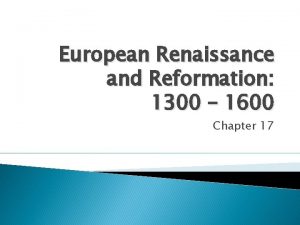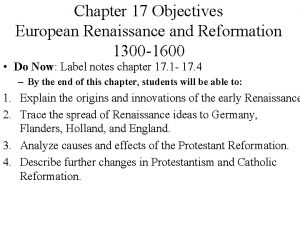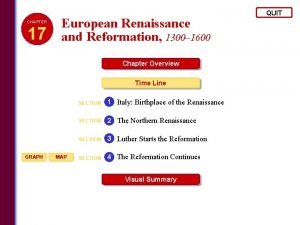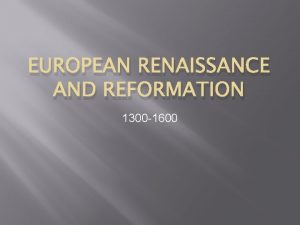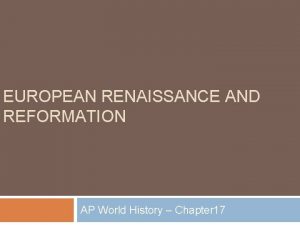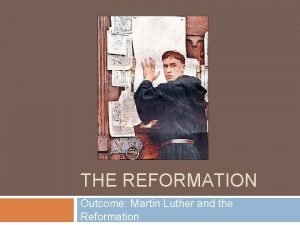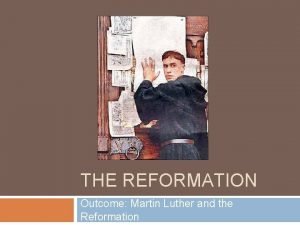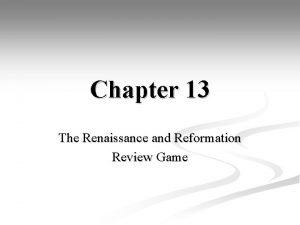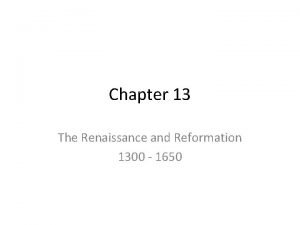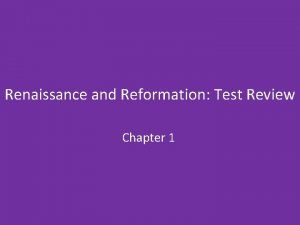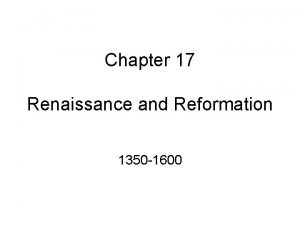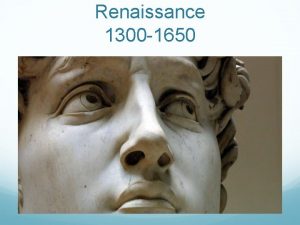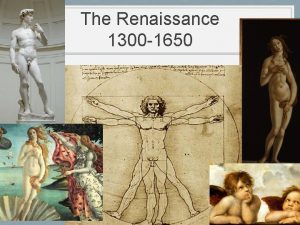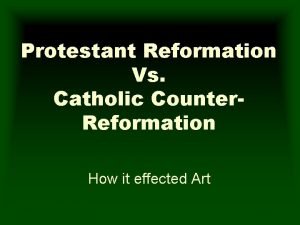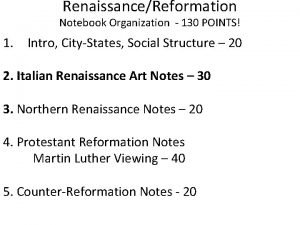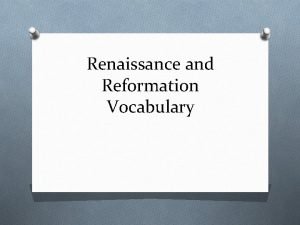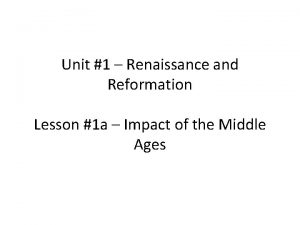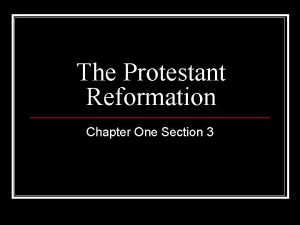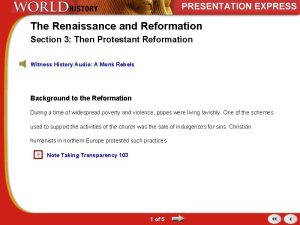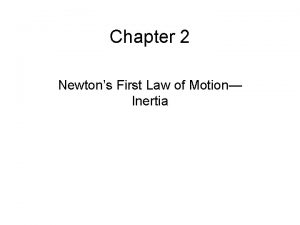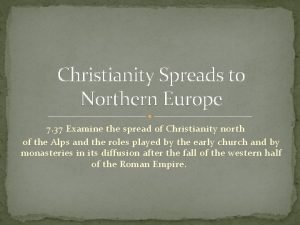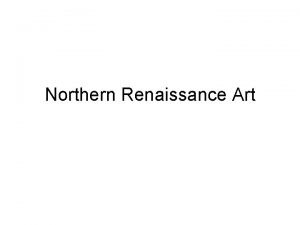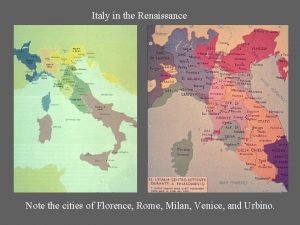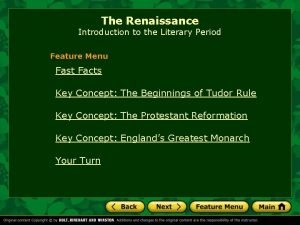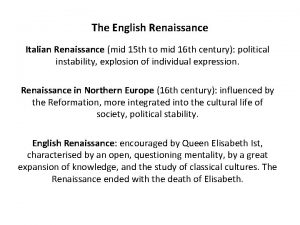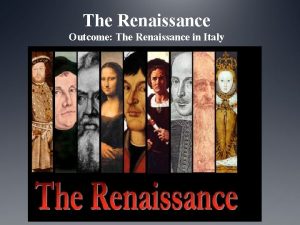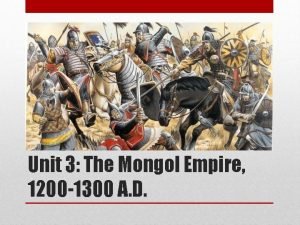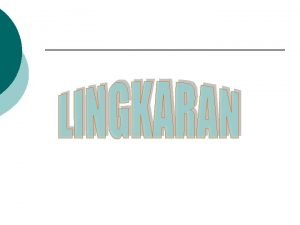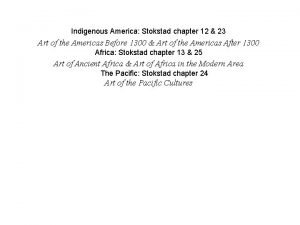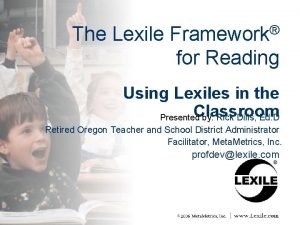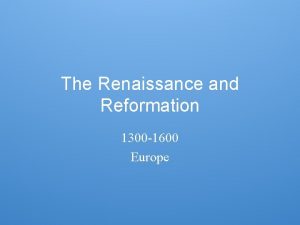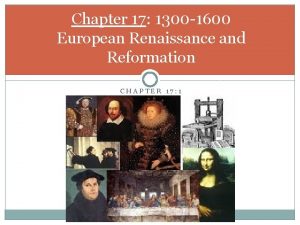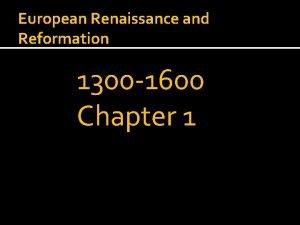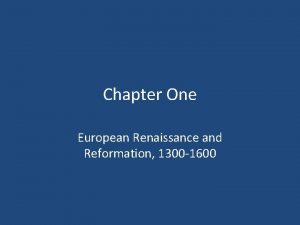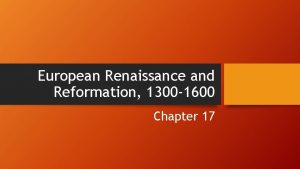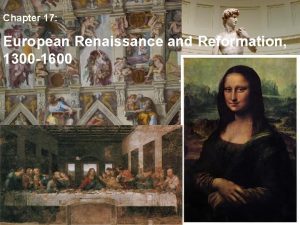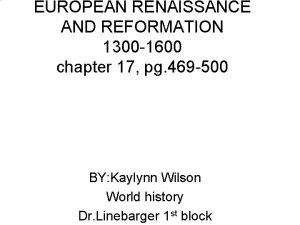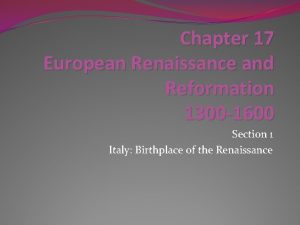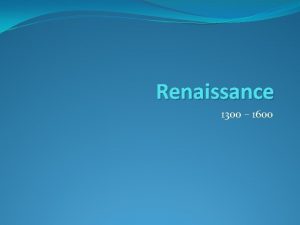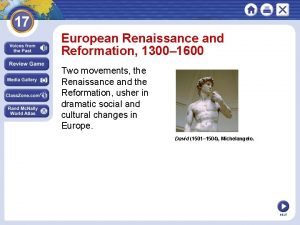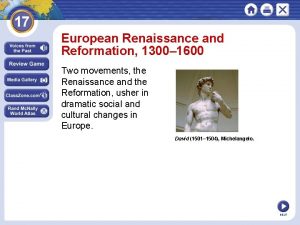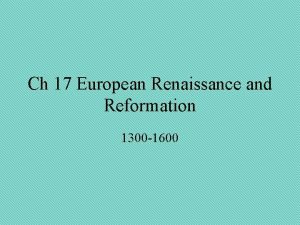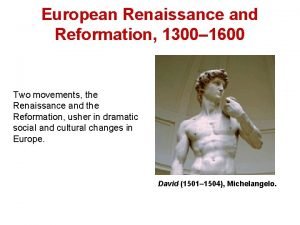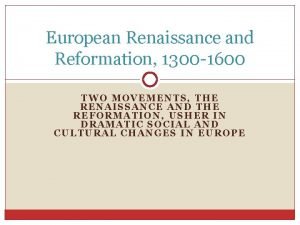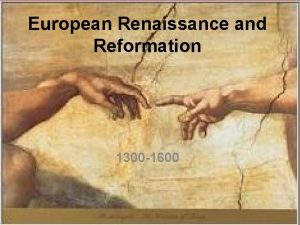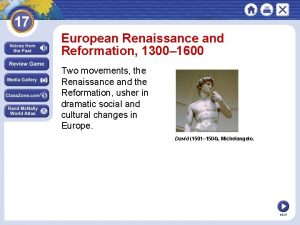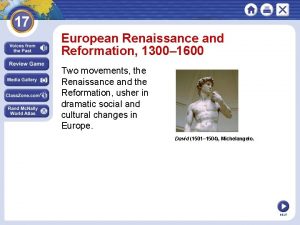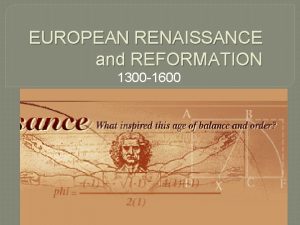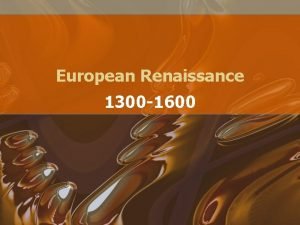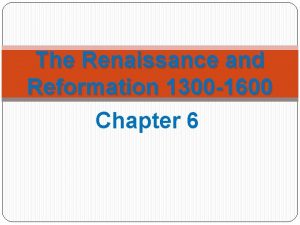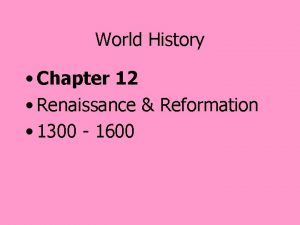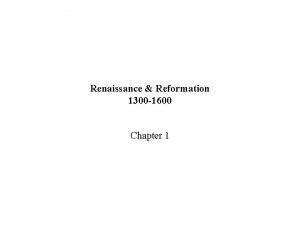European Renaissance and Reformation 1300 1600 Chapter 17





































- Slides: 37

European Renaissance and Reformation: 1300 – 1600 Chapter 17

Italy: Birthplace of the Renaissance Chapter 17, Section 1

Renaissance � Rebirth“ of classical knowledge, art and learning in Europe during 14 th -16 th centuries. � Characterized by ◦ innovative developments in art and literature ◦ new values – importance of the individual ◦ rejection of traditional scholasticism ◦ focus on acquiring knowledge through the newly developing natural sciences

Humanism Cultural and intellectual movement that developed in Europe about 1350’s. � Human being at center stage in the universe; everything seen from the perspective of human beings. � Affected all the arts (architecture, painting, sculpture) and sciences as well as politics, religion, and societal organization. �

Secular � Most people devout Catholics, but basic spirit of Renaissance society was worldly; concerned with secular (here and now). � Humanists suggest person may enjoy life without offending God. � People enjoyed material luxuries, good music and fine food.

Patron � Rich merchants and wealthy families spent huge amounts of money for art. � Provided financial support for artists by becoming patrons. � Allowed wealthy to demonstrate their own importance by donating art to cities. Lorenzo de' Medici

Perspective � Renaissance artists used a realistic style copied from classical art. � Specific techniques to show three dimension on a flat surface. � Sometimes portrayed religious subjects, but also Greek and Roman subjects (mythology).

Vernacular � Renaissance writers produced work that reflected times and used native language (vernacular) in stead of Latin, e. g. Italian and English.

The Northern Renaissance Chapter 17, Section 2

William Shakespeare � Most famous writer form Elizabethan era; possibly greatest playwright of all time. � Born 1592 in Stratfordupon-Avon. � Lived and worked in London; wrote many plays performed in Globe theater: ◦ ◦ Hamlet Macbeth Romeo and Juliet Twelfth Night, etc.

Johann Gutenberg � Large demand for knowledge led to development of printing press by Gutenberg. � Incorporated a number of technologies so that books could be printed quickly and cheaply. � 1455 printed Gutenberg Bible.

Luther Leads the Reformation Chapter 17, Section 3

Indulgences (Selling of Pardons) � Catholic method of exploitation during Middle Ages. � Monetary payment of penalty which, supposedly, absolved one of past sins and/or released one from purgatory after death. � Led the Reformer Martin Luther challenging Roman Catholic authority.

Reformation � Religious movement in the 16 th century. � Reaction against the hierarchical and legalistic structures of the Papacy and the Roman Catholic Church. � Resulted in the split in Christianity between Roman Catholicism and Protestantism.

Lutheran � Martin Luther (14831546) was a monk and teacher. � 1517 wrote 95 Theses; statements posted on church door; suggested church reforms. � Ideas eventually put in practice – followers became known as Lutherans.

Protestant � Many German princes supported Luther: ◦ Believed in his ideas ◦ Saw opportunity to seize church property � Princes loyal to pope agreed to join forces against Luther in 1524. � Several princes signed PROTEST against this agreement; became known as Protestants.

Peace of Augsburg Charles V, Roman Emperor, went to war against German Protestants princes. � Defeated Protestants in 1547, but unable to force their return to the Roman Catholic Church. � 1555 ordered all German princes to meet and sign Peace of Augsburg; each ruler could decide religion of own state. � Presentation of the Augsburg Confession 25 June 1530 before Emperor Charles V

Annul � � Catholics could not get divorced, but the pope has ability to set aside or annul marriage. King Henry from England wanted marriage to Catherine annulled, but pope turned down request. King Henry had Parliament pass laws to end pope’s power; England became Protestant. Parliament passed laws allowing Henry to divorce Catherine and marry Anne of Boleyn. Henry VIII and Anne Boleyn

Anglican � Queen Elizabeth I restored England to Protestantism after short period of being back under power of pope. � Set up Church of England, or Anglican Church, with English king/queen as head. � Kept some features of Catholic service.

The Reformation Continues Chapter 17, Section 4

Catholic Reformation � Millions of people remained loyal to Catholic Church. � Movement with in Catholic Church began to reform itself under Paul III and Paul IV – known as Catholic Reformation.

Council of Trent � Paul III investigated various abuses in RCC. � Church leaders met in Trent 1545 -1563. � Council of Trent bishops and cardinals agreed on several doctrines, e. g. ◦ Church’s interpretation of Bible is final ◦ Christians needed faith and good works for salvation A session of the Council of Trent, from an engraving.

Absolute Monarchs Chapter 21, Section 1, 2 & 5

Absolute Monarch � Ruler with complete and unrestricted power. � Synonyms: autocracy, despotism, totalitarianism Peter, the Great (Russia) Louis XIV (France) Phillip II

Divine Right � The doctrine that kings and queens have a God -given right to rule and that rebellion against them is a sin. � Urged by such kings as Louis xiv of France.

Phillip II Ruler of Spain, Spanish Netherlands and American Colonies. � Seized Portugal when the king died; empire now circled globe. � Fierce defender of Catholic Church; challenged Muslims of Ottoman Empire and Protestants. � Brought wealth to Spain; resulted in inflation. �

Edict of Nantes � Signed on 13 April 1598, by Henry IV of France. � Granted the Calvinist Protestants of France (also known as Huguenots) substantial rights in a nation still considered essentially Catholic.

Cardinal Richelieu French statesman and first minister of France. � Minister of state in 1624. � Cardinal Richelieu was one of the ablest of French statesmen; actual ruler for 18 years. � Richelieu � ◦ enforced the absolute power of the king, ◦ crushed the Protestant Huguenots, ◦ severely punished nobles who plotted against the king, ◦ replaced his enemies in the government.

Skepticism � “Nothing can be known for certain. ” � Doubt or unbelief with regard to a religion, especially Christianity. � Refers to French thinkers reaction to religious wars between Catholics and French Huguenots under leadership of Cardinal Richelieu.

Louis XIV as Louis the Great or the Sun King � Ruled as King of France from 1643 to death. � Achievements: � Known ◦ Refused to let nobles challenge him ◦ Increase wealth of France ◦ Enjoyed life of luxury in court; built Palace of Versailles ◦ Encouraged French settlement in Canada

Charles I � Continued tension between monarchy and Parliament; forced to sign Petition of Rights in 1628. � Tried to dissolve Parliament, going against Petition of Rights.

English Civil War � Scotland threatened to invade England; Charles I requested money from Parliament. � Used opportunity to limit king’s power; Charles I arrested Puritan leaders. � Actions led to English Civil War, 1642 – 1649.

Oliver Cromwell � � � Civil War between Puritans and Royalists. Oliver Cromwell led Puritans to victory. Charles I tried and executed for treason. Cromwell became a military dictator; ruled until 1658. Puritans sought to reform society; forbade dancing, sporting events, etc. Cromwell crushed a rebellion in Ireland, but after his death the government collapsed.

Restoration After Cromwell’s death, government collapsed; new Parliament selected. � Requested Charles II to re -establish monarchy; this period is known as the Restoration Period. � Liberalizing social changes: � ◦ Re-opening of theatres and study of sciences that had been banned by the Puritans. ◦ Established the Royal Society for the study of Science and the Royal Observatory at Greenwich.

Habeas Corpus (1679) � Law requiring a person under arrest to be brought before a judge or into court. � Person can’t be held unless lawful grounds are shown for their detention. � Monarch could no longer put someone in jail for simply opposing the ruler.

Constitutional Monarchy James II’s pro-Catholic policies angered and worried the English; requested William of Orange and James’s eldest daughter, Mary to take over throne. � Led to bloodless revolution that forced King James II to flee to France. � William and Mary agreed to Bill of Rights; no king or queen could rule without consent of Parliament. �

Cabinet Monarch could no longer rule without Parliament, but Parliament also needed approval of monarch. � Cabinet established to that ensure that government did not come to standstill if two parties disagreed. � Headed by leader of ruling party; over time became center of power; �
 Renaissance rebirth
Renaissance rebirth European renaissance and reformation chapter 17
European renaissance and reformation chapter 17 European renaissance and reformation chapter 17
European renaissance and reformation chapter 17 Chapter 17 european renaissance and reformation
Chapter 17 european renaissance and reformation Who wrote praise of folly
Who wrote praise of folly European renaissance and reformation answer key
European renaissance and reformation answer key The reformation outcome: martin luther and the reformation
The reformation outcome: martin luther and the reformation The reformation outcome martin luther and the reformation
The reformation outcome martin luther and the reformation Chapter 13 renaissance and reformation
Chapter 13 renaissance and reformation Chapter 13 the renaissance and reformation
Chapter 13 the renaissance and reformation The renaissance and reformation test
The renaissance and reformation test Chapter 12 renaissance and reformation worksheet answer key
Chapter 12 renaissance and reformation worksheet answer key Chapter 17 renaissance and reformation
Chapter 17 renaissance and reformation 1650-1300
1650-1300 Borgia and medici timeline
Borgia and medici timeline Protestant reformation vs counter reformation
Protestant reformation vs counter reformation Renaissance 1450 to 1600
Renaissance 1450 to 1600 Topic 4 the renaissance and reformation
Topic 4 the renaissance and reformation Renaissance and reformation interactive notebook
Renaissance and reformation interactive notebook Renaissance and reformation vocabulary
Renaissance and reformation vocabulary Unit 4 lesson 1 the renaissance
Unit 4 lesson 1 the renaissance Why did the sale of indulgences become a critical issue
Why did the sale of indulgences become a critical issue The renaissance and reformation section 3 quiz
The renaissance and reformation section 3 quiz Science greatly advanced when galileo favored
Science greatly advanced when galileo favored Causes of renaissance
Causes of renaissance Italian renaissance vs northern renaissance venn diagram
Italian renaissance vs northern renaissance venn diagram The renaissance outcome renaissance painters/sculptors
The renaissance outcome renaissance painters/sculptors Northern vs italian renaissance
Northern vs italian renaissance Last supper labeled
Last supper labeled The renaissance introduction to the renaissance answer key
The renaissance introduction to the renaissance answer key Italian renaissance vs english renaissance
Italian renaissance vs english renaissance The renaissance outcome the renaissance in italy
The renaissance outcome the renaissance in italy Cambulac mongolia
Cambulac mongolia Besar salah sudut pusat segi-18 beraturan adalah .
Besar salah sudut pusat segi-18 beraturan adalah . Besar sudut 1350 = … .
Besar sudut 1350 = … . Art of the americas before 1300
Art of the americas before 1300 Axgate 7000
Axgate 7000 Lexile range 1170l-1320l
Lexile range 1170l-1320l

